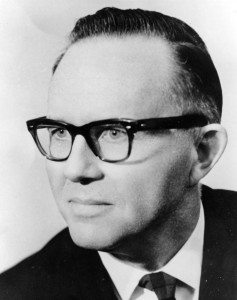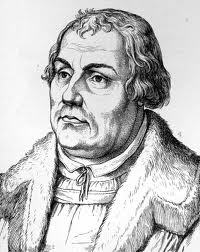Amidst all the frenzy of preparing simultaneously for a new semester and a putative hurricane, I heard today that Eugene Nida had died in Brussels at the age of 96. Newcomers to the field of translation studies may not know his work, but he was indisputably one of the translation theory giants of the mid-twentieth century. I suppose it makes sense that if you live long enough,  you will eventually find your ideas discredited. But I for one am still a fan of Nida’s work. And within his field of specialization – Bible translation – his theories have never really gone out of style. In fact, one might argue that they have remained in style ever since the sixteenth century: Bible translator Martin Luther’s 1530 Sendbrief vom Dolmetschen (Open Letter on Translating) expounds principles that were clear forerunners of Nida’s famous notion of “dynamic equivalence” that he describes in his seminal essay “Principles of Correspondence” (1964).
you will eventually find your ideas discredited. But I for one am still a fan of Nida’s work. And within his field of specialization – Bible translation – his theories have never really gone out of style. In fact, one might argue that they have remained in style ever since the sixteenth century: Bible translator Martin Luther’s 1530 Sendbrief vom Dolmetschen (Open Letter on Translating) expounds principles that were clear forerunners of Nida’s famous notion of “dynamic equivalence” that he describes in his seminal essay “Principles of Correspondence” (1964).
Martin Luther insisted that the translator should observe the way ordinary people speak (
dem Volk aufs Maul schauen) and translate accordingly. He rejected the attribute “full of grace” for the Virgin Mary (remarking: “full of grace the way a barrel is full of beer?”) and

hailed her instead as
Holdselige (sweet/dear/gracious/lovely one). Not mincing words, he declared his adversaries who preferred to “let the Latin language teach them how to write German” to be
Esel (jackasses). Obviously Luther was successful as a translator – his tendentious translation of the Bible launched a whole new branch of Christianity. And Nida, too – who was ordained as a Baptist minister the same year he completed his PhD in linguistics – was profoundly devoted to communicating the word of God. Nida’s notion of “dynamic equivalence” (a.k.a. functional equivalence) was based on the idea that no two languages correspond exactly to one another and that the translator must therefore be attentive to the goals and strategies of the original text, seeking out phrases and concepts in the target language that will achieve a parallel act of communication. This approach makes sense, particularly if you are, say, a missionary who wishes to import religious concepts into a culture in which they are unfamiliar. Local points of reference are then sought to ease in understanding. The ideals of Nida’s “dynamically equivalent” translation include clarity and naturalness of expression. He is not primarily concerned with
literary translation per se.
Now, translation of Nida’s sort stands in direct opposition to the approach advocated by a very different sort of theologian, my hero
Friedrich Schleiermacher, and it is Schleiermacher’s ideas (centering around the aim of preserving cultural and linguistic specificity in translation) that have dominated late-twentieth century translation theory, particularly as practiced by leading theorist
Lawrence Venuti
and his followers (myself included). Just this past winter I attended a lecture by Venuti entitled “The Ruse of Equivalent Effect” at the
American Literary Translators Association conference in which he attacked Nida’s ideas using what wound up striking me as a logical fallacy. Venuti argued that an example given by Nida himself to illustrate dynamic equivalence was flawed, and concluded from this that the principle itself had no validity. It’s quite true that the example in question is offensive to our Schleiermacher-schooled sensibilities (Nida praises J.B. Phillips for expressing the notion “greet one another with a holy kiss” in Romans 16:16 as “give one another a hearty handshake all around”). This translation transplants the cultural context of Biblical times to what makes me think of Connecticut in the 1960s. Obviously this is a grievously outdated way of thinking about translation. But at the same time, Nida is right to recognize that this “holy kiss” is something that won’t make sense to modern readers and to conclude from this that the translator must find a way to address this discrepancy. As I see it, there has to be some way to communicate the essence and function of the kiss while also communicating something about the context in which it served as a form of greeting. In short, I don’t believe that one should have to choose between a Nidean and a Schleiermacherian approach to translation as mutually exclusive alternatives. Each of these two theorists proposed goals that are important for the translator to keep in mind. Ideally, I would like to achieve such a high level of skill at Schleiermacherian translation that my work will also ring true to an adherent of dynamic equivalence.
Incidentally, religion is not the only sphere in which dynamic equivalence is of crucial importance. The one time I had the fortune to experience Eugene Nida in person – in the spring of 1988 at the University of Zurich, where he had been invited to lecture by
Mary Snell-Hornby – he spoke about his most recent project at the time, which involved training translators to work at the U.N. It turns out that in questions of international relations, clarity and naturalness of expression are high on the list of desiderata, just as they are in church.
Share this!
 you will eventually find your ideas discredited. But I for one am still a fan of Nida’s work. And within his field of specialization – Bible translation – his theories have never really gone out of style. In fact, one might argue that they have remained in style ever since the sixteenth century: Bible translator Martin Luther’s 1530 Sendbrief vom Dolmetschen (Open Letter on Translating) expounds principles that were clear forerunners of Nida’s famous notion of “dynamic equivalence” that he describes in his seminal essay “Principles of Correspondence” (1964).
you will eventually find your ideas discredited. But I for one am still a fan of Nida’s work. And within his field of specialization – Bible translation – his theories have never really gone out of style. In fact, one might argue that they have remained in style ever since the sixteenth century: Bible translator Martin Luther’s 1530 Sendbrief vom Dolmetschen (Open Letter on Translating) expounds principles that were clear forerunners of Nida’s famous notion of “dynamic equivalence” that he describes in his seminal essay “Principles of Correspondence” (1964). hailed her instead as Holdselige (sweet/dear/gracious/lovely one). Not mincing words, he declared his adversaries who preferred to “let the Latin language teach them how to write German” to be Esel (jackasses). Obviously Luther was successful as a translator – his tendentious translation of the Bible launched a whole new branch of Christianity. And Nida, too – who was ordained as a Baptist minister the same year he completed his PhD in linguistics – was profoundly devoted to communicating the word of God. Nida’s notion of “dynamic equivalence” (a.k.a. functional equivalence) was based on the idea that no two languages correspond exactly to one another and that the translator must therefore be attentive to the goals and strategies of the original text, seeking out phrases and concepts in the target language that will achieve a parallel act of communication. This approach makes sense, particularly if you are, say, a missionary who wishes to import religious concepts into a culture in which they are unfamiliar. Local points of reference are then sought to ease in understanding. The ideals of Nida’s “dynamically equivalent” translation include clarity and naturalness of expression. He is not primarily concerned with literary translation per se.
hailed her instead as Holdselige (sweet/dear/gracious/lovely one). Not mincing words, he declared his adversaries who preferred to “let the Latin language teach them how to write German” to be Esel (jackasses). Obviously Luther was successful as a translator – his tendentious translation of the Bible launched a whole new branch of Christianity. And Nida, too – who was ordained as a Baptist minister the same year he completed his PhD in linguistics – was profoundly devoted to communicating the word of God. Nida’s notion of “dynamic equivalence” (a.k.a. functional equivalence) was based on the idea that no two languages correspond exactly to one another and that the translator must therefore be attentive to the goals and strategies of the original text, seeking out phrases and concepts in the target language that will achieve a parallel act of communication. This approach makes sense, particularly if you are, say, a missionary who wishes to import religious concepts into a culture in which they are unfamiliar. Local points of reference are then sought to ease in understanding. The ideals of Nida’s “dynamically equivalent” translation include clarity and naturalness of expression. He is not primarily concerned with literary translation per se.

Great post. Thank you.
What Jost said!
Speaking of Bible translation, have you read Willis Barnstone’s Restored New Testament, by any chance? If so, I’d appreciate hearing your impressions.
Great post, thanks! A few thoughts. I have often thought that the literalness (writer-faithfulness) of translations can be plotted on a scale, with legal and technical at one end, and religious translation at the other. Literary translations probably fall somewhere between. Religious translation qua religious translation (not just the translation of religious texts, which could equally be for academic ends) seeks to reproduce or spark in the read the same sensations and elevations (that the translator feels and assumes are) felt by the reader of the original. To succeed at this, religious translation must reach deep into the cultural and personal subjectivities of the target language, touching and resonating with already existing pools of affective and inspirational language. When the translation is strange, it should be so in a transcendent fashion, pointing the reader toward new and alluring realms of experience. “Holy kiss” is strange in this transcendent sense. And it is alluring: I’d like one of those. In Western languages, this strangeness is set against deep familiarity and penetration of the Bible and biblical language, so we tend to mourn its replacement by the more familiar. A more interesting question for me would be the choices facing a translator-missionary to a culture where people never, ever kiss.